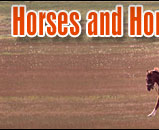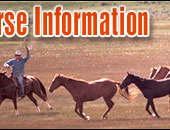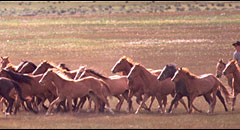 |
   |
|
|
|
You are here: Horses > Horse care > Treat a wound |
|
Horse Injuries and Wounds Treatment First Aid
Anyone who owns a horse needs to be prepared for the
eventuality of wound and injury care. Horses often get hurt or injured in the
normal course of the day, from barbed wire, nails, fencing,
glass or metal. They run into things, step on sharp
objects, or get stuck. If there are deep cuts, puncture
wounds, open sore injuries or things requiring antibiotics, you're going to
need to call the vet, but it's important to be able to
provide your horse with first aid until the vet arrives. |
|
|
Horse's Need Tetanus Shots
You can keep your horse safe from tetanus by making sure he
is vaccinated twice a year. As well as building a good first
aid kit, preventive measure like a tetanus shot can make the
difference between a horse that recovers from even a
simple-looking wound and one that dies from a bacterial
infection. |
Cleaning open horse wounds
The best thing to use in cleaning all sorts of cuts, tears
or abrasions is sterile saline solution. You should always
have some saline in your first aid kit, and plenty of it,
since it's the best way to clean wounds. If you've run out
or are in a place where there is no saline, flush wounds out
anyway with water from a hose. If there's any contact lens
saline around, that will work. The goal in cleaning the
wound by flushing with clean liquid is to wash away bacteria
which might otherwise cause infection, so use plenty of
fluid when flushing a wound, and let the excess pour away,
hopefully carrying bacteria with it to the ground and away
from your horse.
Puncture wounds
Some puncture wounds are more serious than others, either
because of their depth, size, origin or location on the
horse's body. A puncture wound in dense muscle is less
worrisome than it would be on the chest, belly or lower leg,
where it could compromise your horse's internal organs or
his running. Anytime the wound is on the abdomen or chest,
get in touch with the vet. Assuming the wound is on the
upper leg or hip, and has nothing still inside, you can
check the severity of the wound by measuring its depth, then
clean and bandage the wound.
If the wound is bleeding but not very deep and has nothing
left inside, slow or stop the bleeding by pressing on the
spot with sterile gauze pads or a clean towel. If the
bleeding has already stopped, clean the wound by flushing it
out with plenty of sterile saline. If there's no bleeding,
you can also see how deep the wound is by inserting a Q-tip,
but obviously, if your horse objects, leave that to the vet.
In some cases, the object that causes the puncture may have
pulled out leaving some ragged skin or torn tissue that
protrudes into the wound. In this case, don't try to remove
anything; just flush it with sterile saline and wrap it in
dampened bandages.
If the puncture has made a nasty hole in your horse, you may
feel that cleaning the wound will push the dirt or debris
deeper rather than washing it away. If it doesn't look like
you'll be able to effectively rid the wound of debris by
flushing it out, wait for your vet to come. In deeper
puncture wounds or in cases where the object is still in the
wound, the vet will probably X-ray the area before trying to
remove the foreign body. If you try to take it out yourself,
you're more likely to cause more damage than the original
wound. Other cases where a vet is definitely indicated
include wounds that are more than an inch or two in depth,
or wounds that don't want to stop bleeding.
Abrasions
Abrasions usually occur when a horse falls and skids,
skinning her hip, leg or shoulder. If the wound is a simple
abrasion, you can probably take care of it yourself, but
check to make sure there are no punctures, lacerations,
broken bones or other more serious damage before treating
the skin damage.
Assuming there is no other problem, clean the abrasions by
flushing with lots of saline to remove the dirt, grass or
other particles. Apply a disinfectant like dilute Betadine
solution, which will kill bacteria left on the wound. Be
gentle with the skinned area: don't scrub it. Just wash it
down tenderly to avoid causing further pain to your horse
and more damage to the skin. Your horse will be sore for
days (and there may be some bruised muscles contributing to
her discomfort) and it may be a few weeks before large
abrasions are sufficiently healed to get your horse back to
the regular schedule. Hose the area with cool water for pain
relief and to diminish swelling, and if your horse seems
uncomfortable, you may want to get a prescription for an
anti-inflammatory from your vet. After hosing, apply
ointment made of Vitamin E or your favorite ointment to help
the area heal and keep it protected from dirt. If you're
worried about scarring, your vet may be able to treat the
abrasion with laser light, which has been shown to prevent
or reduce scarring.
Laceration
Lacerations usually (but not always) need to be treated with antibiotics to
prevent infection, so you'll probably contact your vet in
all but the most trivial cases. In general (for humans and horses), antibiotics should not be used unless absolutely necessary to treat an existing infection. Common reactions and the possibilites of deveolping a resistance to antibiotics should be throughly discussed with your vet before giving any kind of medication to your horse. Any time there's a cut on
your horse's leg, it's important to pay attention to the
possibility of it causing problems with ligaments or
tendons. If your horse suddenly goes lame, check for small
lacerations you may not have noticed right away; sometimes
even a cut that looks like a superficial skin wound can make
your horse temporarily lame. Being alert to the possibility
means you'll lessen your horse's chances of becoming
permanently lame due to infection or tendon damage.
Put a standing wrap on your horse's other leg to help it
support the additional weight when your horse favors the
injured leg. Look at the wound while you pick up your
horse's leg and flex it normally. You will able to see the
depth of the wound better than when your horse is standing
still. You might be able to see that a tendon or ligament
has been cut, although the laceration looked simple when you
started. Call the vet: your horse may need stitches, and
will probably get a course of antibiotics. The tendon
sheaths, even when the tendon hasn't been injured directly,
are susceptible to bacteria, which causes pain and swelling.
Omitting to treat with antibiotics can cause lameness even
once the cut itself has healed. Your vet will decide about
pain relief options and will advise you in how long to rest
the horse in its stall and when and how to start exercising
him again.
Lacerations involving flaps of skin
Horses sometimes have an amazing way of looking just
awful—covered with blood, skin hanging from a huge
cut—without being in real danger. If you find your horse
with a large amount of skin torn partly off or down the
face, side or hip, your first instinct is right: call the
vet! Your horse will need stitches, and will probably
require tranquilizing before even a professional can take a
good hard look at the wound.
If your horse it taking it all in stride and won't knock
your head off for trying to help, you may be able to flush
the wound with sterile solution before the vet arrives.
You'll be limiting the potential impact of bacteria and
reducing your horse's chances of infection. Obviously, if
your horse is really upset and doesn’t want to be touched,
it's not worth trying to change his mind. Talk to him and be
as comforting as you can until the vet comes.
Once the sutures are on, you may have to do little until the
healing is done, or you may have to deal with weeping wounds
and daily bandage changes. If the wound is dripping for
awhile, you may want to protect the skin that's being
dripped on with a layer of petroleum jelly. This is pretty
much your vet's area: you should get full instructions for
bandage and wound care from him or her.
Injury near a joint
If your horse suffers a wound over the knee or another
joint, you can flush the wound with saline, but should
contact your vet right away. The vet will determine whether
the injury has affected the joint, and may use X-rays or
other methods to check on the severity of the wound. Your
horse may require sutures and will probably have a course of
antibiotics to prevent the wound or the joint from becoming
infected.
Your Horse's First Aid Kit
If your horse does any traveling, you should have two first
aid kits: one in the stable and one in the trailer in case
there's injury away from home.
- Bath and hand towels for applying pressure to slow or stop
heavy bleeding
- Rolls of gauze bandage and gauze squares for dressings.
- Surgical tape and duct tape (for keeping things where you
put them)
- Scissors
- Wrapping bandages
- Leg wraps
- Spray bottle
- Petroleum jelly
- Ointment
- Large syringe for wound flushing
- Sterile saline solution
- Betadine or other disinfectant
- Tweezers
- Q-tips
|
Read the next horse care article on Your Horse's Eyes. |
|
|
|
|
 |
|
|
 |
 |




Over 20 years of experience selling quality horse saddles & show tack.
Huge selection of different saddle types & brands.
Family owned & operated.
Free shipping on all saddles.
Horse Saddle Shop doesn't sell any saddles, owners Dale and Chuck wouldn't buy themselves!
Visit the Horse Saddle Shop today and receive top notch advice on purchasing a horse saddle that fit your riding needs.
|
|
|
 |
|
|
|
Horse Education
|
|
|
|
|
Horse Information Topics
|
|
|
|
|
|
|
|
Horse Business Owners
|
| |
Advertise with Us
Have your horse products or services exposed to over 27,000 of our monthly visitors.
|
|
|
|
|
|